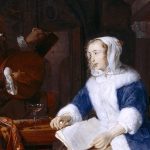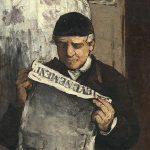The Great War in Portraits at the National Portrait Gallery, London

The National Portrait Gallery is exhibiting a thought provoking series of images of the leaders and ordinary soldiers of all sides who fought during the First World War.
When one enters the first room one is confronted by portraits of the Kings, Emperors and Czars who were on their respective thrones at the outbreak. King George V is portrayed in his robes, Kaiser Wilhelm and Emperor Franz Ferdinand wear their uniforms with all the gold braid and decorations, and there is a silent film of the funeral of King Edward VIII showing the pomp and ceremony of the imperial mourners following his coffin. In the corner a newspaper photograph shows Gavrilo Princip, the assassin, looking every bit a wild eyed, and dishevelled terrorist.
In the next room one finds portraits of the various Generals and Field Marshalls of all sides looking as pompous as they probably were; General Plumer of the British Army looks particularly Blimpish. Hindenburg is in his highly decorative uniform; all sport huge moustaches of a kind that is never seen today. Facing them are the sketches and oils of the rank and file; including William Rogers’ The Dead Stretcher Bearer. On a separate wall Orpen’s painting of the young Winston Churchill broods in his portrait which was commissioned in 1916 just after the disaster of Gallipoli.

But it is the paintings, photographs and drawings of the ordinary soldiers which really show the misery and pity of the war. British artists such as Sickert and Orpen; and on the German side Kirchner, show the ordinary rank and file who fought. In a glass covered case are vintage postcards showing the Generals but also group snapshots of troops from all sides. French, German and British postcards show how every man dreamed of the girl back home.
In one room is a huge square mural made up of smaller photographs of men and women who were there. Some are well known—Siegfried Sassoon, Edith Cavell, Manfred von Richtofen, and the first recorded Afro Caribbean commissioned officer, Walter Tull. Others are unknown; German, black, Indian and white British soldiers, sailors and airmen. Only five are women.
There is a small exhibition of drawings done by Henry Tonks which were used to assist in the facial reconstruction of soldiers who had severe facial injuries caused by shells or bullets. This work was carried out at the Military Hospital in Aldershot from 1915. Pat Barker’s novels “Life Class” and “Toby’s Room” are required reading for more information about this remarkable man and his contribution to reconstructive surgery.
 The silent film of the Battle of the Somme and the German version “Bei unserer Helden an de Somme” made in 1917 plays in a continuous loop.
The silent film of the Battle of the Somme and the German version “Bei unserer Helden an de Somme” made in 1917 plays in a continuous loop.
The last drawing is by Max Berkman in 1919 showing a confrontation between an artist and a disfigured German veteran returning home—a portent of things to come?
This is a balanced exhibition in its choices of subjects except for women’s contribution. There are only five portraits of female participants although we know many British women and others contributed to the war effort.
By Ruth Jellings




